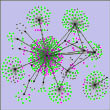Monday, 24 November 2014
Persistence of social signatures in human communication

No need to be impressed anymore by people who have 600 or 1400 “friends” on Facebook. Just like you and I, they are not really discussing their true feelings or anything else important with more than one or two dozen people at most. And for every individual, the size of this limited “hard core” of relationships seems to persist over time, even though the friends who compose it may change. These fascinating cognitive data come from a study entitled “Persistence of social signatures in human communication”, published in the journal Proceedings of the National Academy of Sciences of the United States of America in January 2014.
One of the authors of this study was the famous English anthropologist Robin Dunbar, for whom Dunbar’s number is named. This number represents the quantity of individuals that a human can have in his or her social network, and its value is around 150. Dunbar derived this number from his research on the correlations between the growth in the size of the brain and the growth in the size of social groups among primates. Simply stated, Dunbar’s hypothesis is that the more complex the social group you live in, the bigger the brain it takes to understand who’s who, who does what, who can be of help to you, and so on.
It was thus Dunbar’s training in primatology that led him to formulate this hypothesis. One distinctive trait of primatologists is that often they are interested not in the proximal causes of our behaviours (such as the mechanisms of sexual seduction, or our attraction for sweets) but rather in their distal or ultimate causes (such as the drive to reproduce the species, or the importance of identifying food rich in calories, in order to survive). This tendency gives primatologists a longer-range perspective that lets them find deeper meanings in all kinds of familiar phenomena, such as the kind and number of relationships that people maintain on social networks or in “real life”.
What is interesting about the data in this study, which came from sources such as the telephone calls that the subjects made, is that they corroborate what a sociologist who works for Facebook told the magazine The Economist in 2009 (see last link below). He said that the average number of “friends” on Facebook was about 120 (fairly close to Dunbar’s 150), but that on average, men comment on the statuses of only seven of their “friends”, and women on only 10. These numbers are slightly higher among Facebook subscribers who have about 500 “friends”, but still relatively low: 17 for men and 26 for women.
The recent study by Dunbar and his colleagues confirms this relatively small “hard core” of people who are close to us emotionally and with whom we have a large number of contacts compared with all of our other acquaintances. This study also confirms a certain variability among individuals such as that observed on social networks. But his most original contribution is to show that this “social signature”, which is specific to every individual, remains stable and preserves its particular form over time, despite the inevitable turnover in the people who pass through our lives.
According to Dunbar, all of this gossiping has its origins in the mutual grooming observed among the great apes—the chief activity by which they smooth out their social relationships and confirm their emotional bonds. It is no surprise then that our brains can still electronically “groom” no more than about 10 people, considering all the cognitive resources or simply the time that this activity involves!
![]() Constancy of our social signatures
Constancy of our social signatures
![]() Persistence of social signatures in human communication
Persistence of social signatures in human communication
![]() Primates on Facebook
Primates on Facebook
From Thought to Language | Comments Closed








